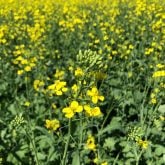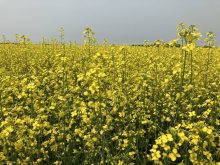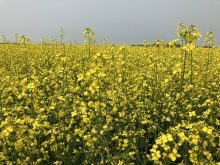Rain fell throughout the province, delaying harvest operations towards the end of the week and over the weekend.
Spring cereal and canola harvest is nearing completion in most areas. Flax, soybean, edible bean, and silage corn harvest is ongoing.
Some areas reported frost on Sunday night. Frost in the Interlake was light, while areas in the Northwest experienced a hard frost.
Seeding of winter wheat and fall rye continues, no reports of emerged crop to date.
- Click here for the Crop Weather Report for the week ending September 17
Read Also

Manitoba sclerotinia picture mixed for 2025
Variations in weather and crop development in this year’s Manitoba canola fields make blanket sclerotinia outlooks hard to pin down
Southwest Region
Harvest activities were halted on the weekend due to rain amounting to 12 to 40 mm. Night time temperatures are cool, but no frost reported.
Spring cereal harvest is 95 to 100 per cent complete with just the odd field of barley or oats remaining. Yield and quality of cereal crops are very good to excellent.
Canola harvest is 60 to 70 per cent complete, with the majority remaining straight cut canola. Canola yields are reported average to above average with good quality. Some reports of green seed in the samples due to dry weather after swathing.
Flax fields continue to be desiccated in preparation for harvest. Some flax has been harvested, but no yield reports yet.
Soybeans are in the R7 to R8 (brown pod/mature) stage of development and most early varieties are mature. Some early varieties have been harvested, no yield and quality reports to date.
Sunflowers are in the late R8 to early R9 stage. Corn silage harvest has begun with average to above average yields.
Winter wheat and fall rye seeding is ongoing.
Some light field work and weed control measures continue in harvested fields.
Pastures that have deteriorated due to dry conditions will benefit from this past weeks rainfall. Most producers have been moving cows to fall grazing. Some producers have begun to wean calves. Dugouts are around 50 per cent full.
Northwest Region
Warm daytime temperatures allowed harvest to progress well, although cool overnights and morning dew delayed morning operations. Over the past week Roblin received 6 mm of precipitation, Swan River 15 mm, Dauphin area 13 to 25 mm, and trace rainfall in The Pas. There was a hard frost in the northern part of the region on Sunday.
Spring wheat harvest is 90 to 100 per cent complete, with yields of 75 to 80 bu/acre around Roblin and 60 to 90bu/acre around Swan River. Barley and oat harvest is generally complete with reports of oats yielding 150 bu/acre and barley yielding 100 bu/acre in the Roblin area.
Canola harvest has also been progressing steadily with 65 per cent of the fields combined around Swan River, and yields of 50 to 60 bu/acre. Canola is 85 per cent harvested around Roblin with yields of 50 to 60 bu/acre. There was good progress on the canola harvest this week around McCreary, Dauphin, and Ste. Rose with only a small amount remaining.
Soybeans and fababeans are approaching maturity with most fields still standing. Pea harvest is complete with yields ranging from 60 to 75 bu/acre in the Roblin and Swan River areas. The flax crop is ripening but harvest operations haven’t yet begun. Fieldwork on harvested fields is well underway.
Silage corn is in the dent stage.
Rainfall over the past weekend will benefit forage stands. Generally, pastures are adequate with minimal supplementation required to meet the nutritional needs of cows at this time. Producers continue to monitor pasture water supplies.
Central Region
The first part of the week was sunny and warm with record high temperatures. Rain at the end of the week and through the weekend resulted in 15 to 25 mm of precipitation. Topsoil moisture conditions have improved with the rain, but subsoil moisture remains low.
Cereal crop harvest is 95 to 100 per cent complete. Early yield reports: hard red spring wheat 55 to 100 bu; northern hard red wheat 80 to 100 bu; barley 75 to 120 bu; oats 110 to 180 bu. Quality, test weight and falling numbers are generally reported as excellent. Protein in wheat is generally average to below average.
Swathing of canola is complete. Western areas report 95 per cent of the canola is harvested, while eastern areas are at 100 per cent complete. Canola yields range from 40 to 65 bus/acre, with very good quality. Harvested seed moisture levels are lower than normal given the dry harvest conditions.
Flax harvest is underway; early yield reports are 27 to 32 bu/acre. Straw is being baled and moved.
Corn is advancing rapidly with warmer weather conditions. Most fields are in the dent stage, with some early varieties approaching physiological maturity.
Field pea harvest is complete, with above average yields ranging from 50 to 90 bu.
Brown pod has been reached in many soybean fields; a good number of fields have been harvested. Early yield reports range from 28 to 40 bu/acre. Moisture levels in harvested seed have been lower than normal causing some seed cracking.
Harvest has started in edible beans. Yields are reported to be 1800 to 2000 lb/acre for pintos, and 2000+ lb/acre for cranberries.
Backs of sunflower heads are yellow; bracts are starting to brown. Some basal stalk rot is evident.
Harvest preparation in potatoes continues; harvest will begin shortly.
Post harvest harrowing and cultivating operations have begun, but in many cases are limited due to dry topsoil. Scraping for surface drain maintenance is underway; good progress being made.
Soil sampling is underway and early results show low soil nitrogen levels remaining given the high yielding crop. Fall fertilization is starting.
Straw is being baled and stacked/hauled off fields; yields are above average.
Second cut hay is complete. Yields are below average due to dry conditions. Wild hay harvest continues. Pastures continue to deteriorate. Pastures on lighter textured soils, and overstocked pastures are browning off, with no regrowth. More rain is needed to stimulate pasture growth.
Livestock water supply continues to decline; 90 per cent reported as adequate. More rainfall is needed to replenish dugouts.
Eastern Region
Last weeks’ weather was conducive to good harvest progress with seasonal to above seasonal temperatures until Friday when daytime temperatures cooled significantly and sporadic showers began. Rainfall amounts over the weekend varied from 10 to 40 mm across the Eastern region, delaying field operations. Average soil moisture conditions on cropland across the region were rated as 85 per cent adequate and 15 per cent. Soil moisture conditions on hay and pasture land were rated at 10 per cent adequate, 40 per cent short and 50 per cent very short. The driest soil conditions are in the southern districts.
Spring wheat harvest is nearing completion in the region, with average yields in the 65 bu/acre range. Wheat protein is averaging between 11 and 13 per cent for the overall crop. Oat yields are in the 150 bu/ac range. Canola harvest is ongoing with approximately 95 per cent of the crop harvested. Yields are in the 45 to 55 bu/ac range.
Soybean harvesting continued last week but was sporadic with the presence of green seeds limiting which field could be done. In some cases, portions of fields have been harvested. Soybeans are currently in R8/dry down or late R7 growth stages. Yields reported range from 20 to 36 bu/acre. Sunflowers were in the R8 growth stage and remained in overall good condition. Corn stage ranges from dent to early physiological maturity depending on the hybrid and area it is being grown. Fall tillage and fertilizer applications were also ongoing last week until the weather put a stop to progress.
Pastures are in rough shape and livestock are being moved to hay fields or are being fed on pasture. Some producers are fencing hay fields to graze. Dugouts are low and a few producers are cleaning and making dugouts bigger. Livestock winter feed supplies were rated as 20 per cent surplus and 80 per cent adequate for hay and straw and adequate for greenfeed and feed grains. Pasture conditions was rated at 30 per cent fair, 50 per cent poor, and 20 per cent very poor. The availability of livestock water was rated as adequate.
Interlake Region
Rain and cooler conditions have stalled harvest in the region. Rainfall this past week has varied from 11 to 21 mm. Very light frosts (-0.1 to -0.8 C) were reported overnight on Sunday at Moosehorn and Narcisse.
Cereal harvest continues with over 95 per cent harvested in the south Interlake. Some ergot, but levels are low. In the north Interlake, spring wheat harvest is 85 per cent complete, while oat and barley are 95 per cent complete. Yields of cereals there are quite good with wheat yielding 65+ bu/acre, barley 120+ bu/acre, oats 125+ bu/acre, fall rye 100+ bu/acre.
The majority of canola is harvested in the south Interlake with combining approximately 95 per cent complete and yields ranging from 40 to 65 bu/acre. A few fields left for straight cutting remain. In the north Interlake canola harvest is near 75 per cent complete, with yields from 30 to 50 bu/acre.
Leaf colour change and leaf drop are noticeable in many soybean fields, and change is rapid with dry conditions/frost. In the south Interlake soybeans are yielding around 30 bu/acre with some green seeds showing up in the sample. Very little soybeans have been harvested in the north Interlake. There appears to be some frost damage on some fields. Most fields in R6 to R7+ stage.
Sunflowers are maturing, backs of heads are yellowing and bracks are starting to brown. Sunflower dessication has started.
Dessication of alfalfa seed fields is ongoing. Seed set seems variable, and late vegetative growth is minimal which should help with dessication results and harvest. Some forage seed fields are being taken out of production due to abundance of supply in the marketplace.
Little post harvest weed control is being done as there is little green growth. Soils are working up lumpy, so tillage is being delayed. No reports of fall fertilization to date.
Soil moisture conditions across the region on cropland are rated as 25 per cent adequate and 75 per cent short, while conditions on hay and pasture are rated as 15 per cent adequate and 85 per cent short.
Soil testing has begun, with soils quite dry to considerable depth. Recharge rains are being welcomed to replenish soil moisture.
Most continually hard grazed summer pastures are used up and cattle are being moved off to other areas and/or supplemental feeding is occuring. Most haying is complete.
Pastures are rated as fair to good and could use more rain in areas. Dugouts are 0 to 40 per cent full and water quality varies from poor to good.


















